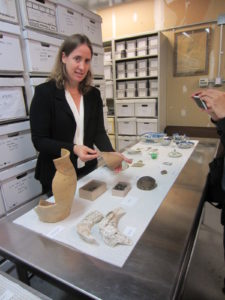
LPC staff archaeologist Jessica McLean discussing select items from the repository. Image Credit: CityLand
The City’s archaeological resources now stored in one secure, climate-controlled space, catalogued, and collection digitized for public. On October 5, 2016, the Landmarks Preservation Commission held a ceremony unveiling the New York City Archaeological Repository: Nan A. Rothschild Research Center at 114 West 47th Street in Midtown Manhattan. The repository holds 1518 boxes of archaeological artifacts in a 1439-square-foor climate-controlled space donated by the Durst Organization. Until consolidated at the repository, the items were stored at multiple locations throughout the City, with varying degrees of access and oversight. In a press release, Landmarks stated that the Center made New York the first municipality to systematically collect, catalogue, curate, and make accessible its archaeological resources.
Landmarks Chair Meenakshi Srinivasan opened the event, in which she noted that, within Landmarks, New York was one of the few municipalities in the nation that retained full-time archaeologists. Srinivasan said that the repository held close to a million artifacts, from 31 sites throughout the City and all five boroughs, which reflected the “diverse layers that make up New York City.” The City has launched a website in conjunction with the repository: nyc.gov/archaeology, making the collection accessible to its residents and the world. Landmarks is also coordinating with the Museum of the City of New York to create a “systematic database’ of the repository.
Amanda Sutphin, Director of Landmarks’ Archaeology Department, stated that “archaeology is a team sport,” and that the repository reflected the work of the wider archaeology community. Sutphin also expressed her hope that the collection would inspire archaeologists to pursue the work still to be done in the City.
Nan A. Rothschild, for whom the Center is named and Professor Emerita at Barnard College, discussed the role and importance of archaeology in understanding the past. Rothschild said that archaeology provides “information about past lives not available from history,” illuminating the technology, industry and diets of the quotidian lives of past societies. For instance, she said archaeology had revealed that sheepshead fish were the preferred seafood of Dutch and English colonists, until the fish’s habitat was destroyed, and demonstrated that a 17th century English embargo on imported goods had been ineffective, given the amount of foreign items from the time period.
Rothschild stated that New York’s archaeological society, PANYC, had long been looking for a suitable site to store the City’s archaeological materials. She also spoke of the role of museums in society, and said the Center met the defining qualities of collection, research, and preservation, with the Web site serving as sort of digital exhibition space.
Iron Mountain Incorporated , working with the Fund for the City of New York, provided financial and professional support for the Center. Iron Mountain’s Kevin Dice said the fit between Landmarks and the company’s Living Legacy Initiative, which seek to protect and make accessible cultural and historic information, was a natural one. He noted that Iron Mountain intended to soon begin imaging maps of historic artifacts and digitizing slides for Landmarks’ web site.
Helena Rose Durst, representing the Durst Organization, said the project represented the family’s passion: the preservation of the City’s heritage, and the Durst family’s contributions to the built environment with the building.
Ceremony attendees, which included several current Landmarks commissioners and former chair Robert Tierney, who serves as a board member for the research center, were then given the opportunity y to view the repository. Landmarks archaeologists manned a display of select items held in the repository displayed by Landmarks archaeologists. The staff archaeologists discussed the items, which included ceramics from the Dutch and English Colonial periods, evidence of historic diets and foodstuff like oysters and a coconut shell, and Native American artifacts. Attendees were invited to explore the repository space, and wander the stacks of boxed artifacts, labeled with the site and date of excavation.
LPC: Open House and Launch of the Na A. Rothschild Research Center, 114 West 47th Street, Manhattan (Oct. 5, 2016).
By: Jesse Denno (Jesse is a full-time staff writer at the Center for NYC Law).

